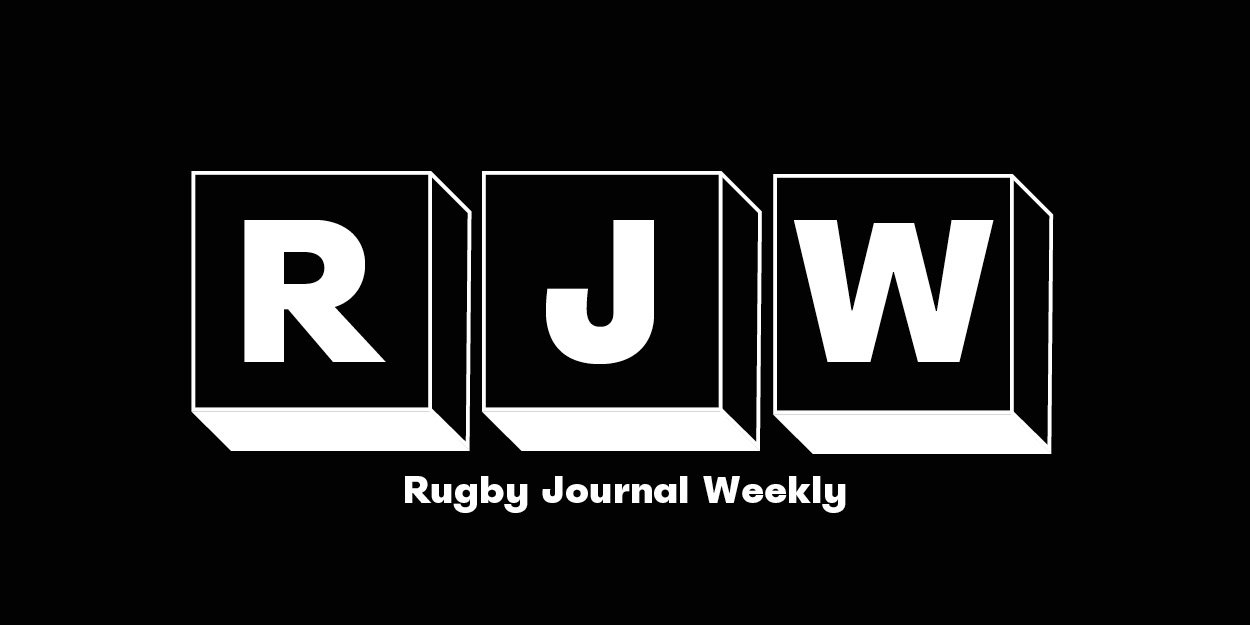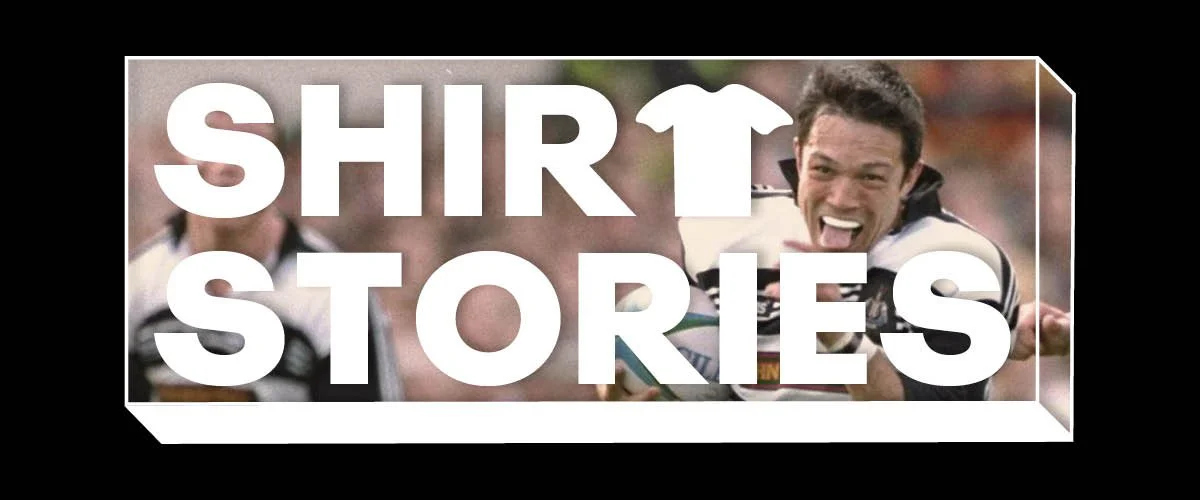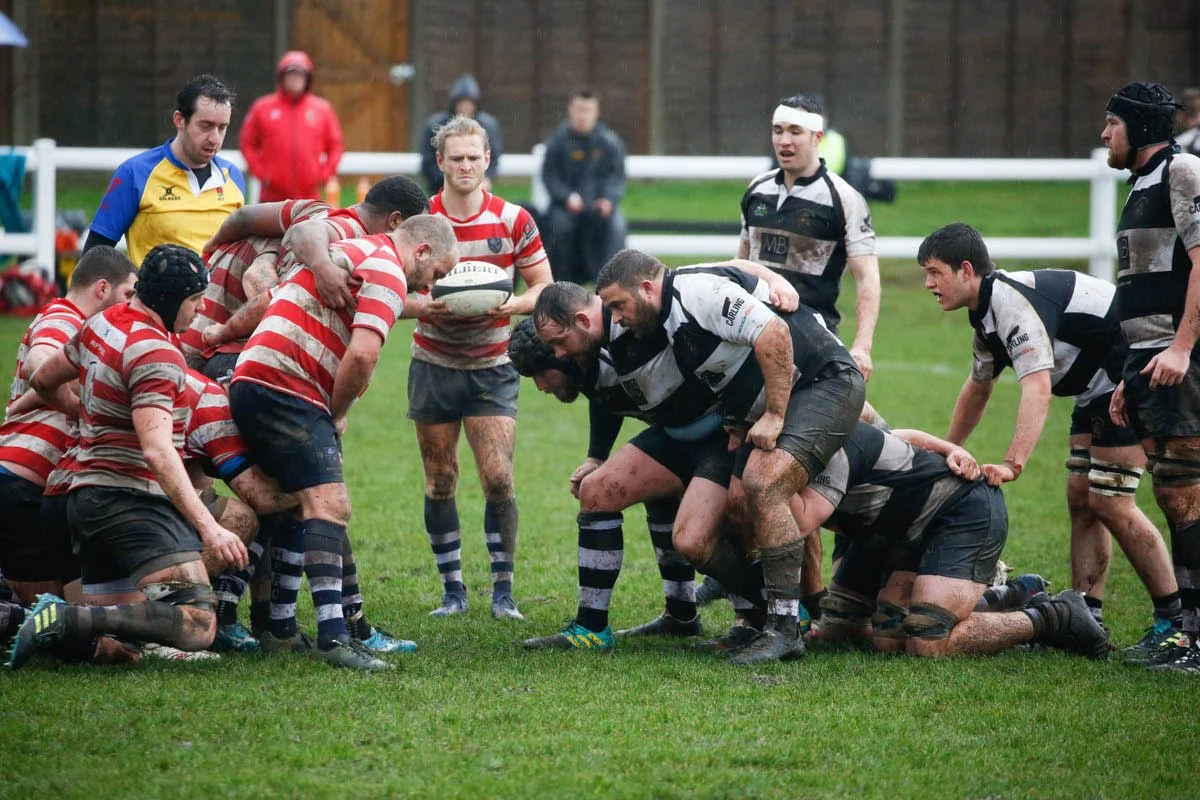
Shirt Stories Newcastle Falcons, 1996-98
Bottoms Up Sutton and Epsom
Ghost Grounds Claro Road, Harrogate RUFC, 1896-2015
Newcastle Falcons, 1996-98
Thirty years on from Newcastle’s sensational 1997/98 Premiership winning season, we take a look at the story of the iconic Adidas shirt that overturned a century-old tradition.
The fairy-tale story of Newcastle Falcons lifting the Premiership trophy at the first attempt is a feat that stands unmatched to this day, their star studded-squad led by director of rugby-player Rob Andrew topping the league by a single point. Having been taken over by Sir John Hall, chairman of Newcastle United Football Club, to become part of his new Newcastle Sporting Club in 1995, the club had experienced an immediate makeover with sweeping changes to their squad, their name, and most interestingly to their playing shirts.
“The club was founded by a group of former Durham School boys as Gosforth Football Club in 1877,” says club archivist Kingsley Hyland. “At the time, Durham School played in green and white hoops. So rather than buy a new set of shirts the club decided to play in green and white hooped shirts, white shorts and green and white socks. It was even written into the clubs constitution that the club's colours would be green and white. However, somebody at some stage had slipped in the word predominantly.”
This detail would prove significant in the years to come. After a decade of decline in the 1980s the opportunity presented by their move to Kingston Park in 1990 prompted the club to modernise, adding ‘Newcastle’ to their name to encourage local businesses to provide sponsorship. However, three seasons later, that hope of investment had yet to be fulfilled.
“People started talking about the club colours,” explains Kingsley. “It was suggested that we might do better if we went to black and white, like the football club.” However, this caused an uproar. “There was massive resistance to that. The club members thought it was sacrilege to change the club's colours. People were saying: ‘No, no, we've always been green and white. We can't change, our constitution doesn't let us’.
“But then, somebody identified this word predominantly. So a design was come up with that had three colours as hoops, green, black and white, but as there was a green and white hoop to every black hoop the shirt was still predominantly in the clubs colours.”
But this change proved to be the start of a gradual assimilation to the familiar black and white. With rugby in the exhilarating early days of professionalism, one of the first changes Hall made was to negotiate a lucrative kit supply contract with Adidas.
“A new shirt was designed for 1995/96, which was predominantly green but with broad black hoops with the three white Adidas stripes against that. However, because the club was now a limited company, they didn’t need a constitution anymore, so it was a small step to convert that design to a white and black shirt at the start of the 1996/97 season.”
Further assimilation came with a change to the club crest. From the date of the Adidas deal, the badges became identical to that of Newcastle United Football Club save for the fact that instead of a seahorse, there was a falcon on either side. “It was entirely from a marketing perspective,” says Kingsley. “At that time St James’ Park had ten thousand on the waiting list, and that was a huge new audience the club wanted to tap into.”
“The members struggled to adapt to all the changes. For years you would still get crowds shouting encouragement, not come on Newcastle or come on Falcons, it was still come on Gos! However, the enlightened ones among us knew this was our one shot at salvation”.
As a hundred years of Gosforth green was brought to a close, the club emerged in 1996 not just with new colours but also a new name. Now Newcastle Falcons, their first ever black and white strip was donned by the likes of Tim Stimpson, Tony Underwood, John Bentley and Dean Ryan as the club stormed Division Two to win promotion. The strip was retained for the following season, joined by their clubs first ever away strip, as the club sealed the Premiership title.
Sutton and Epsom
Lack of availability and long-term injuries are the usual problems associated with life at the foot of the table. For Sutton & Epsom RFC, it was an ex-international Tongan prop and the late-night Friday flight to Las Vegas.
Despite securing a respectable 27 points in Regional 1 South Central, Sutton & Epsom RFC were consigned to relegation, just two seasons after a spell in National Two. It’s safe to say this wasn’t part of the plan.
“We didn’t see this at the beginning of the season,” explains director of rugby Andrew Spooner. “It's just been an interesting time, shall we say, for rugby clubs.”
Pre-seasons preparations went smoothly for Sutton but they were immediately cursed by long-term injuries to key players and new recruits. They lost some early games by a handful of points, a tight 19-22 loss to Oxford Harlequins in late October followed by a 27-30 defeat to Havant a fortnight later.
With a win over Bournemouth straight after the Christmas break the club were poised to kick on, however they were soon met by some unexpected and rather large obstacles.
“We got our arses handed to us a couple of times by some teams higher up the leagues who had players we weren’t expecting at this level,” says Andrew. “Soane Tonga’uiha played against us for Banbury, Tom Varndell for Oxford Harlequins, it wasn’t what we expected at this level. They were exceptional – I remember Tonga’uiha on one occasion had our hooker up on his back, just drove completely underneath him.
“On a different note, we also had a problem with people getting married,” he continues. “Players decided to either go on stag dos or to not have weddings outside of the season. On one occasion the whole of my front row disappeared for two separate weeks. We had to go out and field a team from all over the place.”
An end-of-season push saw results turn their way, saving their best performance till last with a 34-23 win over Bracknell to round off the season. It was a fitting end for some long-term Sutton servants packed and waiting in the departure lounge.
“We had what we called the Last Dance crew, a number of players who’ve come through the club in the last decade and seen us up into National Two. They stuck around through covid, so it was nice to get some results for them.”
Despite relegation, the club as a whole is healthy. They regularly field four men’s sides on a Saturday, the women’s side won their league and the under-22s won the Surrey Cup.
“Actually going down may be good for us,” Andrew says. “I think it gives us another reset opportunity. I think we're in a good place, but I thought we were in a good place last year, so I’m not going to count my chickens.”
Claro Road, Harrogate RUFC, 1896-2015
The ground that Harrogate RUFC called home for almost 120 years, Claro Road was once the chosen home of Yorkshire and where Geoff Cook’s England came to train. Now, streets named after former players are the only reminders of the history beneath what’s now a housing estate.
Founded in 1871, Harrogate (FC) first made home at Dragons Fields before moving to what would be their long-time home at Claro Road in 1896. Kicking off with an 8-6 win over Farsley Athletic, the ground soon became a centre for rugby in Yorkshire and eventually for the country.
Within five years Claro Road played host to the famous Roses match. Yorkshire defeated Lancashire 24-3 in front of a crowd of three thousand on that day in 1900, the memories of that victory convincing Yorkshire to play there for many years to come. With the convenience of the local hotels in Harrogate, Claro Road attracted many a touring side over the years, perhaps most notably the national Canada side in 1903, who beat Harrogate 5-0 on the wettest of pitches.
The 1960s was the heyday of rugby at Claro Road, led by the arrival of Wales international and British Lion Jeff Young in 1964. “He was a formidable player and coach” recalls Brian Forshaw, club historian and former Harrogate captain. “Up until he arrived training was very relaxed, people would just turn up maybe one night a week and have a run around. But Jeff put training on to a more formal basis, similar to what we have these days. With Jeff we started gym sessions to build up strength and fitness, and we were one of the first clubs to be doing it.” This more professional approach proved its worth by 1986, with Harrogate crowned winners of the Sunday Telegraph Pennant competition.
“One of my strongest memories of Claro Road is playing against Coventry in 1973” continues Brian. “They were a top side in the country and their captain was David Duckham, so that was a good game”. Despite the 4-21 score line in favour of the visitors, Brian remembers it fondly. “We also always had a good fixture against Headingly, and Sir Ian McGeehan played for them at the time.” A number of other famous internationals would grace the Claro Road turf over the years; the visit of Harlequins in 1971 brought Nigel Starmer-Smith to the ground, while the likes of Bill Beaumont of Fylde and Roger Utley of Gosforth made more regular visits.
With only three pitches to accommodate six adult teams and a junior section, Harrogate had begun to outgrow Claro Road by the turn of the century. House builders circled to obtain the valuable town centre land, and so the decision was made to leave their spiritual home and move to Rudding Lane in 2015. A 29-18 loss to Hull Ionians spoiled the fairy-tale ending, but with 119 years of memories the ground will never be forgotten.









